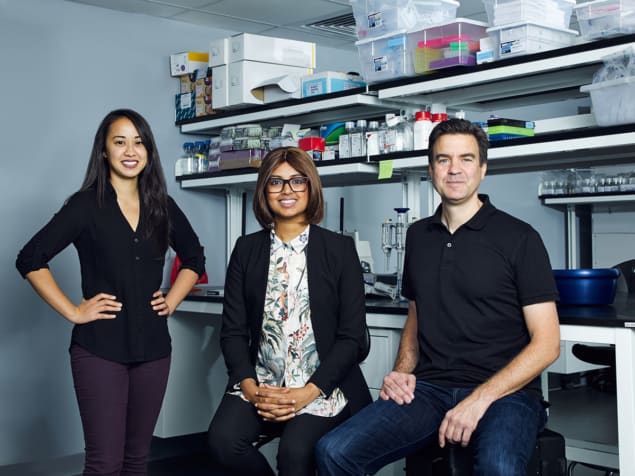Nabiha Saklayen is co-founder and chief executive of US start-up Cellino Biotech, which uses biophysics technologies to advance personalized regenerative medicine. She talks to Julianna Photopoulos about the importance of multidisciplinarity for tackling real-world problems

Nabiha Saklayen is a physicist who has been fascinated with space and stars ever since childhood. “I was obsessed,” she says, adding that this feeling never went away as she got older. Saklayen would often immerse herself in astronomy books that her mum had bought her, dreaming of becoming an astronaut or an aerospace engineer. “They were my most prized possessions,” she recalls.
Growing up in various countries around the world, including Saudi Arabia, Germany and Sri Lanka, Saklayen excelled in science and in many other subjects, such as writing and music. However, she always felt drawn towards her quest to understand the universe, with her interest in physics being piqued while attending a science-focused international high school in Sri Lanka. It was simply the most challenging, appealing and rewarding subject for her. “It pushed me to think outside the box.”
Keen to continue with physics, Saklayen considered studying in the UK. However, she decided it was important to have a broader learning experience than was possible there. “I was committed to physics but I really wanted the option to explore other subjects,” she recalls. Saklayen decided to move to the US, attending Emory University in Atlanta, Georgia, where the interdisciplinary curriculum allowed her to take classes in linguistics, sociology and journalism, in addition to physics.
She graduated with highest distinction, in 2012, majoring in physics with a minor in mathematics. Saklayen points out that another advantage of Emory was the range of research opportunities for undergraduate students. “I started doing research on soft condensed matter, the summer of my freshman year of college in Eric Weeks’ lab, and later published my first paper. This helped me get into a top graduate school.”
Saklayen continued her studies at Harvard University in Cambridge, Massachusetts, and earned her PhD in physics, focusing on biophotonics, in 2017. “I merged physics and biology together. My specific training was in laser physics and I worked with mammalian cells, such as stem cells and blood cells,” she says, adding that she specifically chose biophysics because “it was the closest to real-world applications”.
During her PhD, Saklayen invented new and cheaper laser-based nanopatterned surfaces to engineer cells with precision. “These laser-based methods allow you to create transient pores in cells and deliver cargoes or genetic materials into cells while keeping them healthy and alive,” she explains. Saklayen’s research was carried out in collaboration with many eminent scientists at Harvard Medical School, including the stem cell biologist Derrick Rossi who founded Moderna, haematologist-oncologist David Scadden, and geneticist George Church. “They all were very excited about this laser-based technology and encouraged me to pursue entrepreneurship – and that’s what happened,” she explains. “It was not something I considered for myself.”
Building a multidisciplinary team
After her PhD, in 2017, Saklayen launched a start-up company with physicists Marinna Madrid and Matthias Wagner, initially setting out to treat blood diseases with the technology. She had met Madrid previously when working in the same research group. “We had a fantastic working relationship for many years, so it made sense,” says Saklayen, adding “if she wasn’t my teammate, I don’t know if I would have come this far or if I would have even started the company.”
Later the same year, they met their third co-founder and chief technology officer, Wagner, a serial entrepreneur in the optics field who had previously built and run three start-up companies. Wagner developed the platform technology for commercialization. “Actually, our first version of the platform was built in what I like to call Matthias’ garage,” says Saklayen.
Over the next year, Saklayen narrowed down the potential applications for their platform by researching what the life sciences industry needed. To the team’s surprise, it was more important to be able to remove low-quality cells in a cell culture with the laser than to deliver cargoes into the cell. So this is what they did. “I had not expected this because it’s much easier to remove unwanted cells,” says Saklayen. “That was a pivotal moment.”
For Saklayen, the key thing is that business decisions evolve over time and cannot be based simply on the interests or intellectual curiosity you might have had as a research scientist or a PhD student. “It’s about what is useful for the industry and what customers are willing to pay for,” she says. Soon after, the team met its first seed investors in the form of The Engine, a venture firm spun out of MIT that operates as an accelerator and provides co-working space to its companies. This led them to start working full time on Cellino Biotech in 2018.
We became a unified team across physics and biology, which was very special – not many companies have this type of team that is very balanced across disciplines
Nabiha Saklayen
With the business premises sorted, in Cambridge, Massachusetts, the team immediately hired biologists. “When we first brought our biologists onto the team, we became a unified team across physics and biology, which was very special – there’s not that many companies that have this type of team that is very balanced across different disciplines,” says Saklayen. Cellino Biotech grew again in 2019, when Wagner came up with the idea to form a machine learning team and automate some of the complex processes that are normally done manually by scientists.
“We now use machine learning to train image-based algorithms to decipher which cells are high versus low quality and then we use a laser system to remove any unwanted cells with precision based on those algorithmic decisions,” Saklayen explains. “There are no humans involved in any part of this process.”
The 14 team members working at Cellino Biotech now include four physicists, two biologists and two machine-learning engineers, and the start-up has 12 patents pending. Despite “speaking different scientific languages”, Saklayen stresses how important it has been to work with her multidisciplinary team at Cellino Biotech and make sure everyone communicates well. “It is one of our biggest strengths,” she says. Although she no longer does the science herself, she enjoys being around scientists, advising them and seeing their ideas materialized. “I feel plenty of ownership of our collective efforts,” says Saklayen.
Working hard
As Cellino Biotech’s chief executive, Saklayen’s job is varied and fast-paced: she leads the company’s vision; hires and trains employees; manages her team; organizes logistics and budgets; and fundraises. “Everything moves 100 times faster than anything we ever did in academia,” she says. “I love that energy because you can see that we’re taking massive jumps forward every year.”
However, being an entrepreneur is not easy. “I thought I worked hard on my PhD, but the start-up is even harder,” Saklayen says, noting that she has to constantly think in multiple dimensions. But she finds that being a physicist has really paid off. “It has given me a unique set of tools where I’m able to look at problems from a universal lens and come up with solutions,” she says.

AI for more intelligent drug discovery
During her PhD, Saklayen ran the biophotonics sub-group at Harvard with five or six undergraduate, graduate and postdoctoral students – just like a start-up. “It was unusual but my PhD adviser was completely hands-off,” she says. Saklayen also recalls her previous experience running Model United Nations as an undergraduate student and managing about 100 people. “Both of these experiences built a very strong leadership foundation for me to start from, so I came into this as an experienced leader,” she says. “My mom says I was preparing for this CEO role my whole life without knowing it and there’s some truth in that.”
Having ended up in a career that she hadn’t planned for, Saklayen believes today’s physics graduates have to keep an open mind and talk to scientists in other disciplines to widen their opportunities. “As physicists we’re often very elitist in how we view other disciplines, but don’t fall into that,” she says. As a woman of colour in physics, she also has a message for minority groups in the field. “Don’t let the world get to you; you’re smart, you’re brilliant and you have to keep going,” she says. “It’s an opportunity to educate the world that physicists can look different.”



